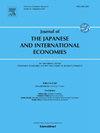尼尔森-西格尔衰减因子和日本的定期保险费
IF 3.1
3区 经济学
Q1 ECONOMICS
Journal of the Japanese and International Economies
Pub Date : 2022-06-01
DOI:10.1016/j.jjie.2022.101204
引用次数: 2
摘要
本研究考察了日本从1990年中期到2020年底的低利率环境,使用动态尼尔森-西格尔框架,强调衰退因素的作用。一个制度转换模型估计,自日本央行量化和定性货币宽松(QQE)政策实施的早期以来,具有低衰减因子和债券收益率波动性的制度(“低”制度)一直存在。从低利率机制的转变可以在预期短期利率几乎没有变化的情况下,通过提高期限溢价,使10年期政府债券收益率立即提高50个基点以上。本文章由计算机程序翻译,如有差异,请以英文原文为准。
Nelson–Siegel decay factor and term premia in Japan
This study examines the low–interest rate environment in Japan from mid-1990 to the end of 2020, using a dynamic Nelson–Siegel framework emphasizing the role of the decay factor. A regime-switching model estimates that the regime with low decay factor and bond yield volatility (“low” regime) has persisted since the early years of Bank of Japan's quantitative and qualitative monetary easing (QQE) policy. A shift away from the low regime can instantly increase the 10-year government bond yield by over 50 basis points by increasing the term premiums with little changes in the expected short rate.
求助全文
通过发布文献求助,成功后即可免费获取论文全文。
去求助
来源期刊
CiteScore
5.10
自引率
6.90%
发文量
36
期刊介绍:
The Journal of the Japanese and International Economies publishes original reports of research devoted to academic analyses of the Japanese economy and its interdependence on other national economies. The Journal also features articles that present related theoretical, empirical, and comparative analyses with their policy implications. Book reviews are also published.

 求助内容:
求助内容: 应助结果提醒方式:
应助结果提醒方式:


